
MS Achille Lauro was a cruise ship based in Naples, Italy. Built between 1939 and 1947 as MS Willem Ruys, a passenger liner for the Rotterdamsche Lloyd, it was hijacked by members of the Palestine Liberation Front in 1985.
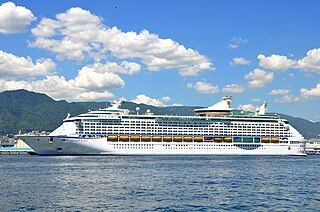
Cruise ships are large passenger ships used mainly for vacationing. Unlike ocean liners, which are used for transport, cruise ships typically embark on round-trip voyages to various ports-of-call, where passengers may go on tours known as "shore excursions". On "cruises to nowhere" or "nowhere voyages", cruise ships make two- to three-night round trips without visiting any ports of call.

An ocean liner is a large passenger ship primarily used as a form of transportation across seas or oceans. Ocean liners may also carry cargo or mail, and may sometimes be used for other purposes.

RMS Aquitania was a British ocean liner of the Cunard Line in service from 1914 to 1950. She was designed by Leonard Peskett and built by John Brown & Company in Clydebank, Scotland. She was launched on 21 April 1913 and sailed on her maiden voyage from Liverpool to New York on 30 May 1914. Aquitania was the third in Cunard Line's grand trio of express liners, preceded by RMS Mauretania and RMS Lusitania, and was the last surviving four-funnelled ocean liner. Shortly after Aquitania entered service, World War I broke out, during which she was first converted into an auxiliary cruiser before being used as a troop transport and a hospital ship, notably as part of the Dardanelles Campaign.

Swedish American Line was a Swedish passenger shipping line. It was founded in December 1914 under the name Rederiaktiebolaget Sverige-Nordamerika and began ocean liner service from Gothenburg to New York in 1915. In 1925 the company changed its name to Svenska Amerika Linien / Swedish American Line.

MS Monarch was the second of three Sovereign-class cruise ships owned by Royal Caribbean International. Beginning on April 1, 2013, Monarch was operated by RCCL's Pullmantur Cruises, before being sold for scrap in 2020 following Pullmantur's closure. The ship was built in 1991 at the Chantiers de l'Atlantique shipyards in Saint-Nazaire, France.

MS Homeric was a cruise ship built in 1986 at the Meyer Werft shipyard in Papenburg, West Germany as Homeric for Home Lines, and their last newbuild to remain in active service. In 1988 she was sold to Holland America Line, renamed Westerdam, and in 1990 lengthened by 36.9 m at Meyer Werft. In 2002 she was transferred to the fleet of Costa Cruises and renamed Costa Europa. In April 2010 she was taken on a ten-year charter by Thomson Cruises, under the name Thomson Dream.

MS Vistafjord was an ocean liner that was built as a combined liner/cruise ship in 1973 by Swan Hunter Shipbuilders in the United Kingdom for the Norwegian America Line. In 1983 she was sold to Cunard Line, retaining her original name until 1999 when she was renamed Caronia. In 2004 she was sold to Saga and sailed as Saga Ruby until sold in 2014 for use as a floating hotel and renamed Oasia. This never came to fruition. Her owners went bankrupt, and in April 2017 she arrived at Alang, India for scrapping.

MS Skaubryn was a Norwegian passenger ship launched in 1950, which sailed between Europe and Australia. She sank in the Indian Ocean in April 1958, after a fire.
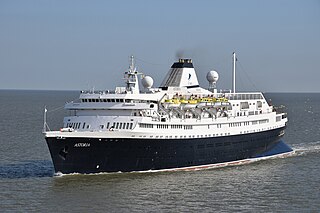
MV Astoria is a ship that was constructed as the transatlantic ocean liner Stockholm for Swedish American Line, and rebuilt as a cruise ship in 1993. Ordered in 1944, and commenced service in 1948, at 73 years old, she is the oldest passenger liner still sailing in deep water routes. As Stockholm, she was best known for an accidental collision with Andrea Doria in July 1956, resulting in the sinking of the latter ship and 46 fatalities off the coast of Nantucket, Massachusetts, United States.

MS Sagafjord was an ocean liner built in 1965 by Société Nouvelle des Forges et Chantiers de la Méditerranée for Norwegian America Line as a combined ocean liner/cruise ship. Between 1983 and 1996 the Sagafjord was operated by Cunard Line. In 1996–1997 she was briefly operated by Transocean Tours as MS Gripsholm prior to being sold to Saga. She was last owned and operated by Saga Cruises on worldwide cruises targeted at the senior market out of the United Kingdom, known as the MS Saga Rose. She was retired in 2009 and scrapped in 2010.

MS Oslofjord was an ocean liner built in 1938 by A/G Weser Shipbuilders, Bremen, Germany, for Norwegian America Line. She was of 18,673 gross register tons, and could carry 860 passengers. She would had a uneventful career until in 1939 were two separate incidents happened. One 27 April 1939, Oslofjord collided with the American an pilot boat, and other were she struck a mine sinking her.
Oslofjord is the fjord leading up to Oslo, Norway.
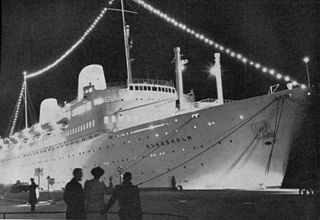
MS Kungsholm was a combined ocean liner / cruise ship built in 1953 by the De Schelde shipyard in Vlissingen, the Netherlands for the Swedish American Line. Between 1965 and 1981 she sailed for the North German Lloyd and their successor Hapag-Lloyd as MS Europa. From 1981 until 1984 she sailed for Costa Cruises as MS Columbus C. She sank in the port of Cadiz, Spain after ramming a breakwater on 29 July 1984. The vessel was refloated later that year, but sent to a Barcelona shipbreaker in 1985 for scrapping.

Leif Höegh & Co is a shipping company founded in 1927 by Norwegian Leif Høegh (1896-1974). Since 2006 the company has been structured as two separate entities, Höegh Autoliners and Höegh LNG, with Leif Höegh & Co acting as a common holding company.
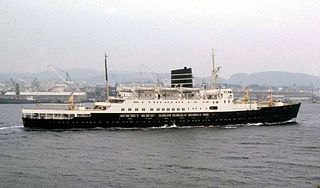
TS Leda was operated by Bergen Line between Britain and Norway as a North Sea ferry for over 20 years from 1953. She was rebuilt in 1981 as a cruise liner and later became an accommodation vessel at a penal colony for terrorists and members of the Mafia. In 2002, whilst being broken up, she was boarded by Greenpeace campaigners protesting about conditions in the shipbreaking industry.
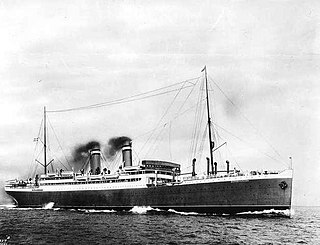
SS Bergensfjord was a Norwegian ocean liner that sailed for the Norwegian America Line to the United States. During the Second World War she was requisitioned by the British Ministry of War Transport and used as a troop ship. After the war she continued sailing as a Trans-Atlantic passenger liner, first for South American owners, then for an Israeli company.
MS Ravnaas was a Norwegian cargo ship built in 1931, and sunk by Japanese aircraft in the Pacific Ocean in December 1941.

The Jubilee class were a group of five passenger and cargo ocean liners built by Harland and Wolff at Belfast, for the White Star Line, specifically for the White Star Line's service from the UK to Australia on the Liverpool–Cape Town–Sydney route. The five ships in order of the dates they entered service were:
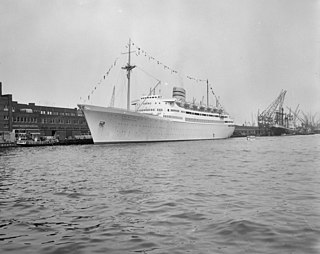
MS Bergensfjord was an ocean liner built in 1955 by Swan, Hunter & Wigham Richardson Ltd, for Norwegian America Line. She was of 18,739 gross register tons, and could carry 878 passengers. She would had a uneventful career with her original owners until she was sold to the Compagnie Générale Transatlantique in 1971, than to the horeson & Company and Bruusgaard Kiosterud & Co, before she was sold to the Aphrodite Maritime Co. She was sunk in 1980 after a fire broke out on board.


















